
Spain’s gender pay gap and gender bias in a reduced workweek
Despite recent progress, Spain continues to demonstrate a sizeable gender pay gap, albeit similar in magnitude to neighbouring countries. Further narrowing this gap will entail both a policy response, as well as likely reliance on emerging technologies.
Abstract: Cyclical and structural factors (i.e., uneven sharing of childcare responsibilities) underpin a continued gender pay gap in Spain – with women’s salaries ranging between 19% and 30% less than their male counterparts, but in line with that of other neighbouring EU countries. Spanish Law 39/99 on Work-Life Balance was one of the most ambitious pieces of legislation on the global level in attempting to regulate work hour flexibility for family reasons, granting both male and female employees under this contract a high degree of flexibility and protection against dismissal. In practice, however, woman account for over 95% of employees taking advantage of such contracts. Thus, the law has failed to reduce the gender gap in terms of taking shorter and more flexible working hours, as well as created a rift between women protected by this type of contract and those who are not, whether because they do not have children of qualifying age (under 12) or because they work under temporary contracts. Going forward, reducing the gender gap will entail: (1) an increase in male burden sharing in childcare responsibilities; and, (2) a reduction in the cost of offering working hour flexibility, possibly with the help of reliance on new technologies.
What we know about the gender gap: The evidenceThe gender pay gap (the difference between what men and women earn) has been the recent focus of social and political debate. The gender pay gap in Spain is similar to that of other neighbouring countries. The estimates vary depending on the method and database used. For example, measured in terms of average gross annual earnings, women in Spain earn between 19% and 30% less than their male counterparts – Conde and Marra (2016), De la Rica (2012) and González (2017), among others. González (2017) uses data from the so-called Wage Structure Survey and estimates a gap between the median gross annual earnings of men and women of 19 points in 2006, narrowing to 13 points by 2014. The fact that the gender gap narrowed during the Great Recession is not exclusive to Spain. A similar trend is observable in other countries in the vicinity and may be attributable to the fact that the economic crisis destroyed many relatively unproductive male-dominated jobs, a phenomenon not fully offset by the entry of women into the workforce to replace their partners (Dolado
et al., 2017)
[1].
Beyond the trend attributable to cyclical factors, the gender pay gap stems from a series of structural factors. There is a bounty of academic research into the causes of the differences between what men and women earn (Blau
et al., 2013). In general, the research finds that the gender pay gap cannot be fully explained by the characteristics of working women such as their level of education or experience. In Spain, for example, the higher average level of education presented by the women in the workforce should result in a lower pay gap but their reduced work experience has the opposite effect, such that these two factors cancel each other out (González, 2017). There is a growing body of opinion, underpinned by empirical evidence, that a significant portion of the pay gap is due to the fact that women are over-represented in jobs and companies offering low salaries, coupled with the fact that those companies offer more flexible working hours relative to the rest (Golding, 2014). The literature has not been able to demonstrate whether this unfavourable segregation of women is the result of a voluntary choice (preferences), the result of discrimination on the part of employers (
e.g., at the time of hiring) or the result of the different roles adopted by men and women in the home, perhaps pushed by social norms and prevailing traditions. What is certain is that there is a very high correlation between the advent of the gender pay gap and maternity (Goldin, 2014), which has given rise to the concept of the ‘family pay gap’; indeed, there is even evidence that women earn more than men before the birth of their first child
[2].
Thus, a significant aspect of the gender pay gap is the higher percentage of women in part-time work after the arrival of their first-borns. While it is true that part of the high rate of part-time work among women in Spain is involuntary (the inability to find full-time work)
[3], it is similarly true that the percentage of people who take part-time work for family reasons is overwhelmingly female.
Several studies show that part-time work results in a penalty or handicap not only in terms of gross annual salaries but also in terms of hourly wages. The latter component of the pay handicap is partly attributable to the relatively slower accumulation of work experience while working part-time which persists even if these women later return to full-time work
[4]. Moreover, it has been estimated that part-time work is generally linked with higher job instability in terms of both contracts (temporary) and episodes of unemployment (higher in number). This pernicious dynamic ends up trapping women in this kind of work, making the transition to full-time work increasingly less likely.
However the gap between male and female pay cannot be explained solely by the fact that more women work part-time than men: even comparing male and female pay for full-time work there tends be a wage gap in favour of the men. Several studies have demonstrated that not all full-time jobs are equal and that women tend to focus on jobs that offer working hours that are more compatible with work-life balance objectives. In the United States it has been estimated that the concentration of women in jobs with lower salaries only explains 15% of the gender pay gap, while the concentration of women in companies with less demanding and more flexible working hours, but that pay less, explains a far higher percentage. This is to say that women and men with similar levels of education and even performing similar work end up earning very different amounts because the men work in companies with more demanding working hours that pay more per hour worked (Betrand et al., 2010).
In a recent study into the difference between the hourly wages earned by male and female drivers at Uber in the United States (Cook
et al., 2018), the authors found that the female drivers earned approximately 7% less than their male counterparts. Although that difference may seem small, it is important to underscore that we are talking about the same company and the same job. Furthermore, the study focuses on hourly wages, correcting therefore for the differences in the number of hours men and women work. What’s fascinating about this study is that it was conducted in a context in which the existence of discrimination against women can be ruled out with a high level of confidence as the formula used by Uber to remunerate its drivers is ‘gender blind’,
i.e., it does not take into consideration whether the driver is male or female but rather depends on purely objective criteria such as the distance travelled or the time taken to perform the service. In addition, on the consumer side of the equation, the authors demonstrated that the level of user acceptance of the service was the same whether it was to be provided by a man or a woman. The authors managed to explain the entire pay gap by three factors. Some fifty per cent was due to the fact that the women drove different routes and at different times of the day than the male drivers, both the routes and times of day in question being less lucrative. For example, there are fewer female drivers on one of the most profitable routes, early morning trips to the airport. The other 50% of the pay gap was explained in equal amount by the following two factors. Firstly, the female drivers are less experienced than their male counterparts because they work fewer hours a week than the men and also because they take more time off than the men
[5]. Secondly, the women drive more slowly than the men, so that they complete fewer services than the men per hour. In short, two-thirds of the pay gap is explained by factors related to the women’s working hours which differ from those of the male drivers and results, via different channels, in lower pay per hour.
This recent study, therefore, suggests that female participation in domestic chores, in particular childcare, prevents them from participating in the workplace under the same conditions as men, creating working hour restrictions that translate into a pay handicap. The rest of this paper describes the incidence of flexible working hours on men and women in Spain before and after the birth of their first child, going on to focus on what is perhaps the most important piece of legislation in Spain in terms of facilitating work-life balance: Law 39/99 (November 5th, 1999), which regulates and protects the right of men and women to reduce their working hours to care for young children.
Part-time work in Spain and childcareBy way of an initial approximation of the relationship between part-time work and childcare, Exhibit 1 shows the percentage of men and women working part-time as a function of the number of years before and after the birth of their first child. And by way of comparison, we also show the percentages for men and women without children, measured using the same age intervals as for the men and women with children. The data comes from the Continuous Work History Sample (CWHS) and covers the years from 2005 to 2015 and individuals aged between 16 and 45. In all instances the percentage of men working part-time is lower than that of women. However, the difference between the two genders increases after the birth of their first child. The percentage of women working part-time doubles between year one and two after the birth of their first child, increasing from 15.7% one year before the arrival of their firstborns to 31.3% two years on. In contrast, the percentage of men working part-time remains steady at around 4.8%. The comparison with the series corresponding to individuals of the same age without children reveals a downward trend in the incidence of part-time work over time for both men and women. There is, however, a gap between men and women that is virtually constant at around 11 percentage points. Both the men and women with children initially present a lower incidence of part-time working arrangements than the men and women who are not going to have children. This gap continues to be observed over time, albeit narrowing, in the case of the men. But in the case of the women it inverts, with the percentage of mothers in part-time work outstripping the percentage of women without children. On the whole, although it is true that more women without children work part-time than men without children, the difference virtually triples after the birth of the first child, going from 11 percentage points one year before the arrival of the firstborn to 28 percentage points five years later.
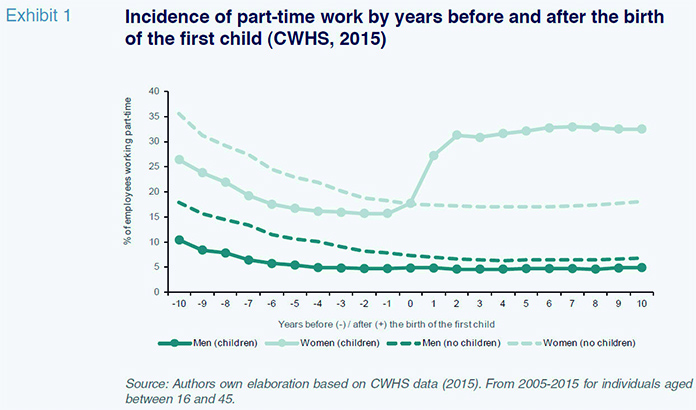
In short, Exhibit 1 corroborates what we already know from other data sources: the women assume the primary role, relative to men, in caring for their young children and this has an evident impact on the labour market.
Reduced working hour contracts to care for young children (Spanish Law 39/99)On November 5
th, 1999, the Spanish government passed Law 39/1999 on the promotion of work-life balance, legislation still in effect today. This piece of legislation is one of the most ambitious in the world in attempting to legislate working hour flexibility for family reasons in terms of its scope and depth. This law permits all salaried employees with children under the age of 12 to reduce their full-time working hours by between one-eighth and one-half, with a proportionate reduction in salary (with the exception of additional pay benefits)
[6]. The reduction in work day does not affect the number of days of vacation the person availing of the measure is entitled to, their jobless claims coverage or, during the first two years, their retirement, disability, widowhood or maternity benefits. After the first two years the last four benefits are reduced proportionately to the reduction in working hours. Employees can decide what hours they want to work and are entitled to change their working hours freely, including the total number worked, by giving two weeks’ notice in writing. Even if it is the employer that usually determines the work shifts, the employee can choose his or her shift.
In order to prevent companies from turning down such requests, the law prohibits firing any worker who has previously applied to reduce their working hours on account of family responsibilities. Employers are obliged to rehire any such employees into their previous jobs, settle any back pay, lawyers’ fees, expert witness fees and other court costs. Protection is, therefore, very high; indeed, it is even higher than that afforded under standard indefinite employment contracts. However, this protection applies
de facto to employees on permanent contracts: if a company does not want to accept an application made by an employee on a temporary contract, all it has to do in practice is to not renew the contract when it terminates (or not transform it into an indefinite contract), an opportunity that generally presents itself in a relatively short period of time
[7].
The law is worded to entitle both fathers and mothers to avail of the option of reducing their working hours for family reasons. In theory, it is designed to reduce the differences between men and women in working hours and work-life reconciliation, particularly considering the strong protection afforded employees availing of this contractual arrangement, whether male or female. However, Exhibit 2 illustrates how in practice virtually only women avail of this contractual option. Moreover, they only do so when they are protected by a permanent contract. Panel (a) of Exhibit 2 shows that 20.8% of all eligible mothers –
i.e., those with children under the age of 12 – in fixed employment are working under the reducing working hour contract regulated in Law 39/99 (47.6% measured as a percentage of all eligible mothers working part-time; Panel (b)). The incidence of eligible men availing of this formula is virtually nil, at just 1.0%. As remarked earlier, the guarantees provided under Law 39/99 are effective in practice only if the employee is protected by an indefinite contract. This is evident in the fact that less than 1% of eligible fathers and only 1% of eligible mothers avail of this contractual arrangement when they hold temporary contracts.
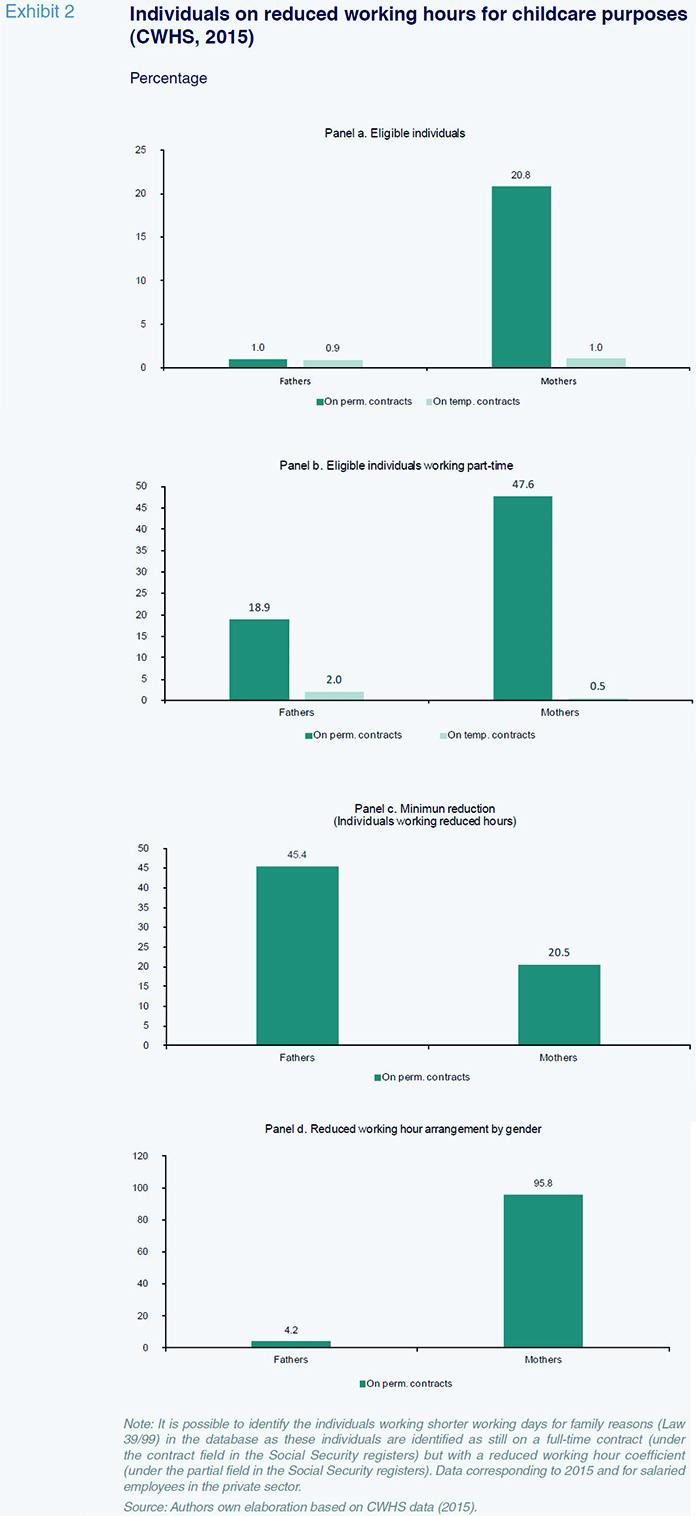
As for the minimum reduction in working hours (one-eighth of the total), shown in Panel (c), it is surprising that the men top this particular ranking, accounting for nearly half of all the working hour reductions in this category. In short, not only do men opt for the reduced working hour arrangement for family reasons far less often but when they do they tend to reduce their hours by the minimum amount. In the case of the women, the minimum one-eighth reduction accounts for a by no means insignificant 20.5% of the total. Exhibit 3 shows that the percentage of women availing of the reduced hours formula is higher at larger-sized companies (measured by the number of employees) and in higher-skilled work.
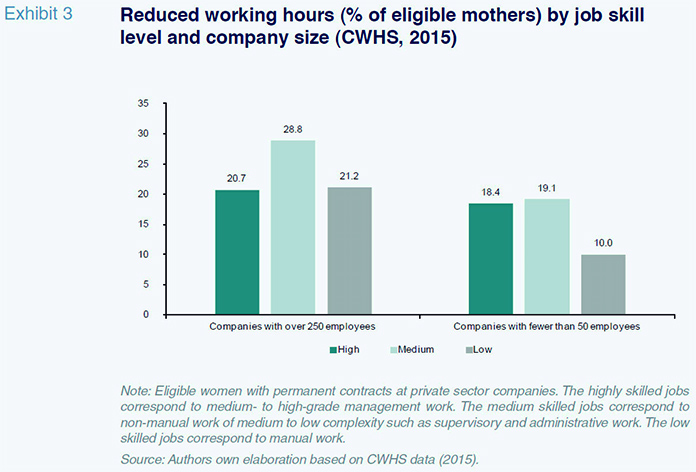
In total, therefore, of all the reduced working hour contracts availed of for family reasons, 95.8% correspond to mothers and just 4.2% to fathers (Panel (d), Exhibit 2). It is therefore a contractual arrangement that brings into ultra sharp contrast the gender differences prevailing in relation to childcare and working hours. These stark gender differences are eye-catching in the context of Law 39/99, as the legislation offers clear incentives for not only mothers but also fathers to opt for this contractual arrangement: almost bullet-proof protection against unfair dismissal coupled with the option of reducing working hours by a minimum amount with a similarly minimal corresponding pay cut.
The high level of protection against dismissal offered by this contractual arrangement is illustrated in Exhibit 4. This exhibit analyses company-employee separation rates in a given year. It is also based on the CWHS database, but this time measures the percentage of individuals who remain in the employment of the same firm from one year to another
[8]. The focus is on the women with indefinite contracts, dividing them into two groups: those that have availed of the reduced working hour measure (Law 39/99 contract) compared with other women with similar socio-economic backgrounds who were not eligible for the shorter working day on account of not having children under the age of 12. Panels (a), (b) and (c) of Exhibit 4 provide the separation rates for these groups of women for all companies; companies with more than 250 employees; and companies with fewer than 20 employees, respectively. As shown in the exhibits, the women on reduced working hours (Law 39/99 contracts) report significantly lower separation rates than women of similar characteristics who have not reduced their hours. These differences are higher at larger enterprises (>250 employees) and when comparing women working reduced hours and non-eligible women in part-time work and with children aged over 12. The gap in separation rates is particularly high in 2008-2009, the year of the Great Recession in which job destruction was at its highest. For example, in Panel (a), the women on reduced hours present a separation rate 14.5 percentage points (or 61.7%) lower than that presented by non-eligible women with older children and working part-time (8.9% for the former versus 23.4% for the latter). It is hard to know whether the job stability of the women availing of the reduced working hours is attributable to the higher cost of laying these women off or the fact that these women are not willing to abandon a permanent position with reduced hours for fear of losing the benefits associated with this type of contract. However, the fact that the differences between the two groups of women were higher during the years of peak job destruction points to the high cost of dismissal as the main culprit.
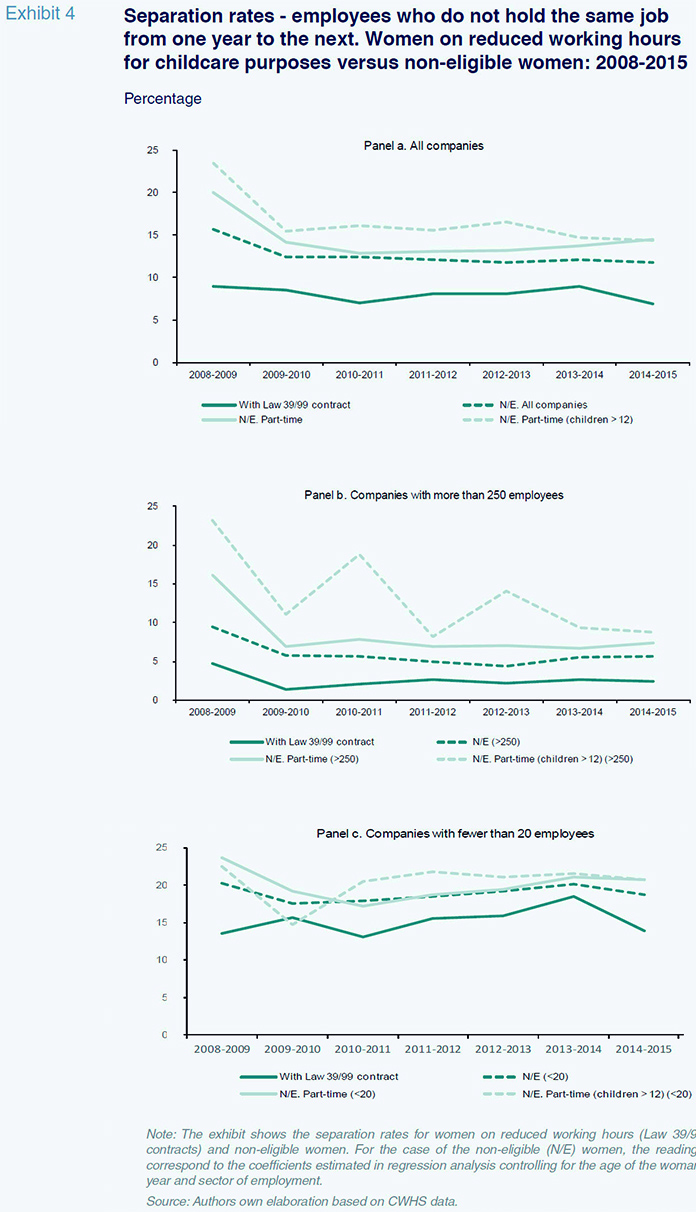
It has been shown that the labour costs of the Great Recession were much higher for employees who had to leave their jobs and cope with new contracts offering far lower salaries
[9]. In this respect, the reduced working hours contract covered by Law 39/99 would appear to have benefitted the women who were able to avail of it by affording them additional protection against dismissal. Exhibit 8 shows the correlation between working hour reductions and the rate of job destruction at the economic activity level (NACE-99 codes at the 2-digit level). This analysis focuses on the female employees who between 2008 and 2015 kept the same job at the same company and who in 2007 had not reduced their working hours but had been eligible at some subsequent point. As shown in the exhibit, the percentage of eligible women who availed of this contractual arrangement at some point between 2008 and 2015 was highest when the pace of job destruction in their sector of activity was higher
[10]. When controlled for the age of the individual, job category, province, company size and age of the child in the regression analysis, the results show that for every 10% of additional job destruction there is a 3.48% increase in the probability that an eligible woman will avail of the reduced hour formula (Table 1); this percentage increases when zooming in on the percent of minimum working hour reductions, rising as high as 9.46% in the case of companies with fewer than 75 employees.
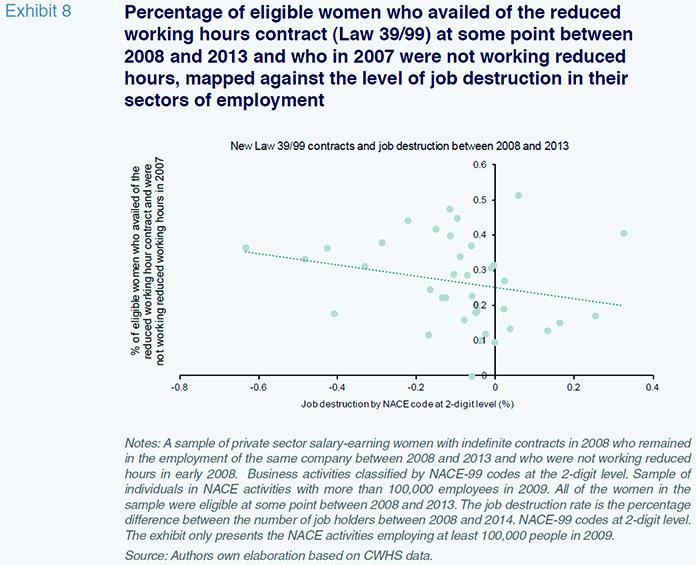
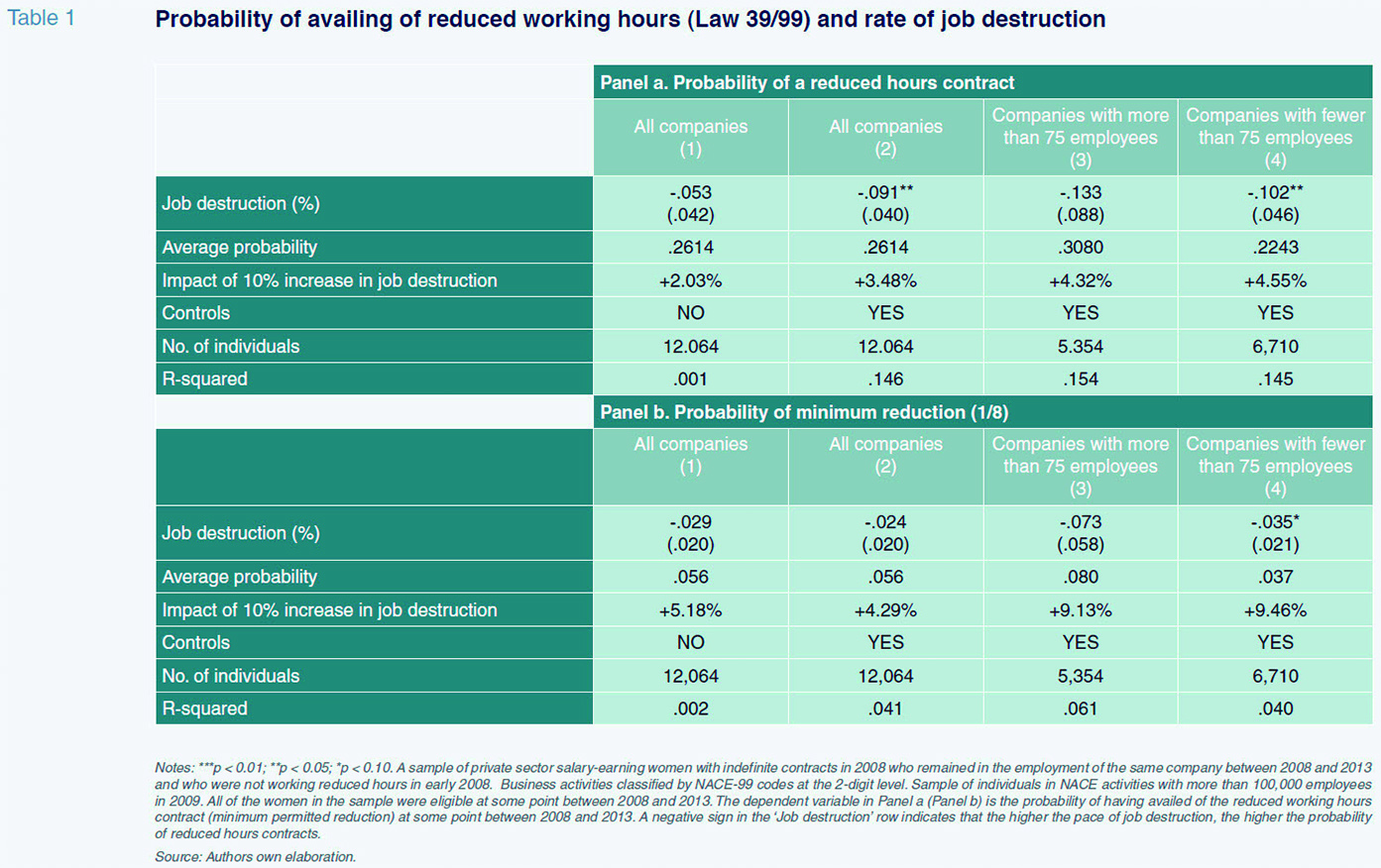
ConclusionsDespite the progress made on gender equality in Spain in recent decades, women continue to take more responsibility for childcare than men. These family responsibilities limit many women’s ability to enjoy the same pay conditions as men, all the more so in a labour market such as Spain’s, which is still dominated by inflexible working hours and long work days. Law 39/99 on Work-Life Balance regulated the reduction of working hours for family reasons, granting the employees availing of this contract a high level of working hour flexibility and protection against dismissal. Despite this level of protection and the fact that the law grants men the same rights as women, in practice only women have availed of this arrangement, accounting for over 95% of all such contracts. The law has therefore failed to deliver its goal of reducing the gap between men and women in terms of taking shorter and more flexible working hours in order to reconcile their work and private lives. Moreover, even though it is true that the women availing of this contractual arrangement have enjoyed a higher level of job protection and stability than other women of similar characteristics, it is also true that only those enjoying permanent contracts have been able to avail of the arrangement in practice. As a result, the law has opened up a new gap, between women protected by this type of contract and those who are not, whether because they do not have children under the age of 12 or because they are working under a temporary contract. Lastly, it cannot be ruled out that this regulation may be having unintended adverse effects on the universe of women of child-bearing age, such as a lower probability of finding work, or at least a permanent contract
[11].
Reducing the gender gap requires two strategies: (1) getting men more involved in caring for their children; and, (2) reducing the cost of offering working hour flexibility.
As for the first strategy, progress is being made on the policy front, such as the concept of non-transferable paternity leave (Farré and González, 2017)
[12]. However, policies of this type do not reduce the cost to the company of offering flexibility; they simply distribute them more equitably between men and women. Moreover, their impact will remain limited as long as there continue to be major differences by gender, such as in the case of paternity leave in Spain, which at four weeks is just one-quarter of maternity leave
[13]. As for the second strategy, Goldin (2014) has demonstrated that emerging technology is reducing the costs of flexible working hours with possibly greater effectiveness than most existing public policies.
Notes
Olivetti and Petrongolo (2008) demonstrate that correcting for the bias introduced by the low participation of women in the workplace, the gender pay gap is substantially higher than the unadjusted estimate (i.e., without correcting for this bias) in the South of Europe, including Spain.
Refer, for example to Fernández et al. (2013) in relation to Spain and to Waldfogel (1998) for a review of the research focused on the United States.
Refer, for example, to De la Rica, S. “A vueltas con la jornada parcial en España” [Revisiting part-time working arrangements in Spain]
nadaesgratis.es, 2014.
Refer, for example, to Connolly and Gregory (2009), Manning and Petrongolo (2008) for the United Kingdom, Hirsch (2005) for the United States and Fernández-Kranz and Rodríguez-Planas (2011) for Spain.
The authors find that the male and female drivers learn at the same pace, i.e., the number of hours at the wheel in an Uber car results in a similar performance by gender; it is simply that the women work fewer hours and that leads them to earn less per hour than the men.
The maximum age of a child for qualifying for this measure was increased to eight years of age in 2007 and then to 12 in 2012. In addition, the minimum reduction in weekly working hours was set at one-eighth in 2007, having been one-third before that. Applications to reduce working hours to care for children under this age must be made in writing with two weeks’ notice.
According to Spain’s national statistics office, the INE, in 2017, 32% of the people working under temporary contracts in Spain had contracts with a duration of less than six months. It is important to note that the law does not address the conversion of finite-duration contracts into permanent contracts.
This analysis uses the 2015 wave of the CWHS. Given the nature of this data, it is possible that the estimated separation rates falls short of the actual rates. That is because the 2015 wave only features female employees that had a relationship with the Social Security in 2015, whether via employment or the collection of benefits (such as unemployment benefits). What this means is that if, for example, a woman was employed in 2008 but lost her job in 2009 and subsequently depleted her entitlement to claims in the ensuring years, she would not be included in the 2015 wave. Given that the analysis focuses on female employees with indefinite contracts in 2008, this issue is presumably relatively minor. At any rate, the analysis should be understood as more representative of female employees with a strong attachment to the job market.
Refer, for example, to the post by José I. García, Marcel Jansen and Sergi Jiménez on September 29th, 2014, on nadaesgratis.es, titled El derrumbre de los salarios inciales [The collapse in starting salaries]
De la Rica and Gorjón (2016) find the opposite in an analysis which compares the incidence of reduced working hour contracts in 2004-2007 with the economic crisis of 2008-2011. The contrasting findings may be attributable to the different methodology used or the different years of analysis. Also, in March 2007, Law 39/99 was amended to reduce the minimum reduction (from 1/3 to 1/8), and increase the child age limit from 6 to 8). These changes mean that it is particularly difficult to conduct an analysis that compares the level of adoption of the working day reduction contract before and after 2007.
De la Rica and Gorjón (2016) find evidence of these unintended effects using the 2004 CWHS. In a piece of research in progress (Fernández-Kranz and Rodríguez-Planas, 2013), we are analysing the effects of the legislation over a longer timeframe, using the 2010 CWHS, and we have found evidence that following the approval of Law 39/99, companies may have become more reluctant to hire women of child-bearing age or offer them an indefinite contract, an unintended adverse effect that is gaining traction over time.
Farré and González (2017) analyse the impact of the introduction of non-transferable paternity leave in Spain in 2007. The authors find that this policy has had a limited impact in the long-run, offering by way of possible explanation the still-short duration of this leave, particularly in comparison with maternity leave.
Non-transferable paternity leave was introduced for the first time in 2007 and was set at two weeks. In January 2017, it was extended to four weeks. Mothers currently have 16 weeks’ leave, 10 of which can be transferred to the father. However, less than 2% of fathers take any of this potential time off.
References
BERTRAND, M.; GOLDIN, C., AND L. F. (2010), “Dynamics of the gender gap for young professionals in the financial and corporate sectors,”
American Economic Journal: Applied Economics 2, no. 3: 228-55.
BLAU, F. D.; FERBER, M. A., AND A. E. WINKLER (2013),
The economics of women, men, and work Pearson, 7 edition.
CONDE RUIZ, J. I., AND I. MARRA DE ARTIÑANO (2016), “Gender gaps in the Spanish labor market,” FEDEA,
Estudios sobre la Economía Española, 32.
CONNOLLY, S., AND M. GREGORY (2008), “Moving Down: Women’s Part-Time Work and Occupational Change in Britain, 1991–2001,”
Economic Journal, vol. 118: F52–F76.
— 2009, “The Part-Time Pay Penalty: Earnings Trajectories of British Women,”
Oxford Economic Papers, vol. 61 no. S1 : 76-97.
COOK, C.; DIAMOND, R.; HALL, J.; LIST J., AND P. OYER (2018), “The Gender Earnings Gap in the Gig Economy: Evidence from over a Million Rideshare Drivers,” No. 00634. The Field Experiments Website.
DE LA RICA, S. (2012), “La brecha salarial de Género en España: Algunas aclaraciones,” [The gender pay gap in Spain: a few pointers]
nadaesgratis.es.DE LA RICA, S., AND L. GORJÓN (2016), “The impact of family-friendly policies in Spain and their use throughout the business cycle.”
IZA Journal of European Labor Studies 5, no. 1: 9.
DOLADO, J. J.; GARCIA-PENALOSA, C., AND L. TARASONIS (2016), “The Changing Nature of Gender Selection into Employment: Europe over the Great Recession,”
Working paper.
FARRÉ, L., AND L. GONZÁLEZ (2017), “The Effects of Paternity Leave on Fertility and Labor Market Outcomes.” (2017)% IZA Discussion paper #10865.
FERNÁNDEZ-KRANZ, D., AND N. RODRÍGUEZ-PLANAS (2011), “The part-time pay penalty in a segmented labor market.”
Labour Economics 18, no. 5: 591-606.
— (2011), “Unintended Effects of a Family-Friendly Law in a Segmented Labor Market,”
IZA discussion paper, 5709
— (2013), “Can Parents’ Right to Work Part-Time Hurt Childbearing-Aged Women? A Natural Experiment with Administrative Data,”
IZA working paper, 7509.
FERNÁNDEZ-KRANZ, D.; LACUESTA, A., AND N. RODRÍGUEZ-PLANAS (2013), “The motherhood earnings dip: Evidence from administrative records,”
Journal of Human Resources, 48, no. 1: 169-197.
GOLDIN, C. (2014), “A grand gender convergence: Its last chapter,”
The American Economic Review, 104: 1091-1119.
GONZÁLEZ, L. (2017), “Más sobre tendencias en el mercado laboral español” [More about the trend in the Spanish labour market],
nadaesgratis.es.HIRSCH, B. (2005), “Why Do Part-Time Workers Earn Less? The Role of Worker and Job Skills,”
Industrial and Labor Relations Review, 58(July):525–51.
MANNING, A., AND B. PETRONGOLO (2008), “The Part-Time Pay Penalty for Women in Britain,”
The Economic Journal, 118: F28–51.
OLIVETTI, C., AND B. PETRONGOLO (2008), “Unequal pay or unequal employment? A cross-country analysis of gender gaps,”
Journal of Labor Economics, 26, no. 4: 621-654.
WALDFOGEL, J. (1998), “Understanding the Family Gap in Pay for Women with Children,”
Journal of Economic Perspectives, Vol. 12, No. 1 (Winter): 137-56.
Daniel Fernández Kranz. IE Business School